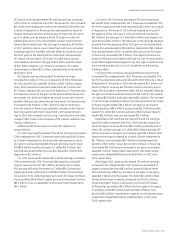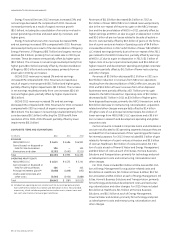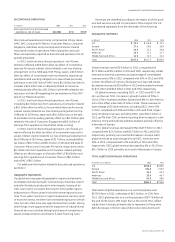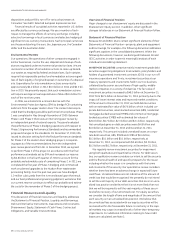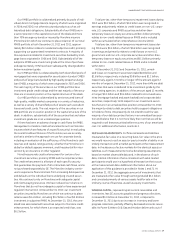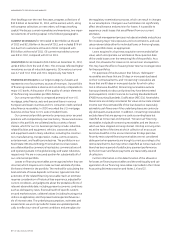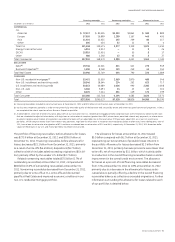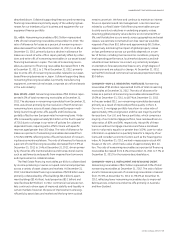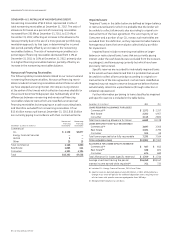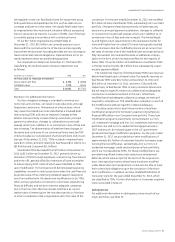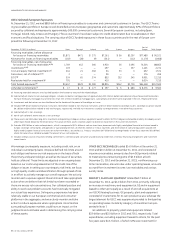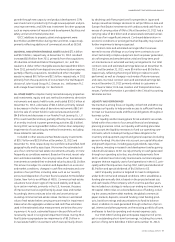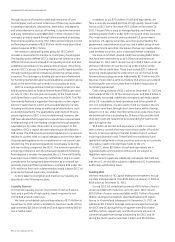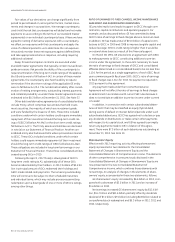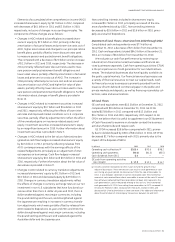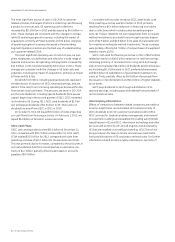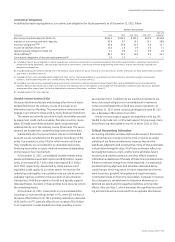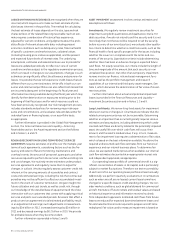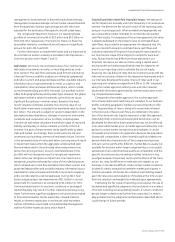GE 2012 Annual Report Download - page 57
Download and view the complete annual report
Please find page 57 of the 2012 GE annual report below. You can navigate through the pages in the report by either clicking on the pages listed below, or by using the keyword search tool below to find specific information within the annual report.
management’s discussion and analsis
GE 2012 ANNUAL REPORT 55
We regularly review our Real Estate loans for impairment using
both quantitative and qualitative factors, such as debt service
coverage and loan-to-value ratios. We classify Real Estate loans
as impaired when the most recent valuation reflects a projected
loan-to-value ratio at maturity in excess of 100%, even if the loan
is currently paying in accordance with contractual terms.
Of our $5.7 billion impaired loans at Real Estate at
December 31, 2012, $5.3 billion are currently paying in accor-
dance with the contractual terms of the loan and are typically
loans where the borrower has adequate debt service coverage to
meet contractual interest obligations. Impaired loans at CLL pri-
marily represent senior secured lending positions.
Our impaired loan balance at December 31, 2012 and 2011,
classified by the method used to measure impairment was
as follows.
December 31 (In millions) 2012 2011
METHOD USED TO MEASURE IMPAIRMENT
Discounted cash flow $ 6,704 $ 8,858
Collateral value 7,278 8,444
Total $13,982 $17,302
See Note 1 for additional information.
Our loss mitigation strategy is intended to minimize eco-
nomic loss and, at times, can result in rate reductions, principal
forgiveness, extensions, forbearance or other actions, which
may cause the related loan to be classified as a troubled debt
restructuring (TDR), and also as impaired. Changes to Real
Estate’s loans primarily include maturity extensions, principal
payment acceleration, changes to collateral terms and cash
sweeps, which are in addition to, or sometimes in lieu of, fees and
rate increases. The determination of whether these changes to
the terms and conditions of our commercial loans meet the TDR
criteria includes our consideration of all relevant facts and circum-
stances. At December 31, 2012, TDRs included in impaired loans
were $12.1 billion, primarily relating to Real Estate ($5.1 billion), CLL
($3.9 billion) and Consumer ($3.1 billion).
Real Estate TDRs decreased from $7.0 billion at December 31,
2011 to $5.1 billion at December 31, 2012, primarily driven by
resolution of TDRs through paydowns, restructuring, foreclosures
and write-offs, partially offset by extensions of loans scheduled
to mature during 2012, some of which were classified as TDRs
upon modification. For borrowers with demonstrated operating
capabilities, we work to restructure loans when the cash flow and
projected value of the underlying collateral support repayment
over the modified term. We deem loan modifications to be TDRs
when we have granted a concession to a borrower experiencing
financial difficulty and we do not receive adequate compensa-
tion in the form of an effective interest rate that is at current
market rates of interest given the risk characteristics of the loan
or other consideration that compensates us for the value of the
concession. For the year ended December 31, 2012, we modified
$4.4 billion of loans classified as TDRs, substantially all in our Debt
portfolio. Changes to these loans primarily included maturity
extensions, principal payment acceleration, changes to collateral
or covenant terms and cash sweeps, which are in addition to, or
sometimes in lieu of, fees and rate increases. The limited liquid-
ity and higher return requirements in the real estate market for
loans with higher loan-to-value (LTV) ratios has typically resulted
in the conclusion that the modified terms are not at current mar-
ket rates of interest, even if the modified loans are expected to be
fully recoverable. We received the same or additional compen-
sation in the form of rate increases and fees for the majority of
these TDRs. Of our $4.4 billion of modifications classified as TDRs
in the last twelve months, $0.2 billion have subsequently experi-
enced a payment default.
The substantial majority of the Real Estate TDRs have reserves
determined based upon collateral value. Our specific reserves on
Real Estate TDRs were $0.2 billion at December 31, 2012 and
$0.6 billion at December 31, 2011, and were 3.1% and 8.4%,
respectively, of Real Estate TDRs. In many situations these loans
did not require a specific reserve as collateral value adequately
covered our recorded investment in the loan. While these
modified loans had adequate collateral coverage, we were still
required to complete our TDR classification evaluation on each of
the modifications without regard to collateral adequacy.
We utilize certain short-term (three months or less) loan
modification programs for borrowers experiencing temporary
financial difficulties in our Consumer loan portfolio. These loan
modification programs are primarily concentrated in our non-
U.S. residential mortgage and non-U.S. installment and revolving
portfolios. We sold our U.S. residential mortgage business in
2007 and as such, do not participate in the U.S. government-
sponsored mortgage modification programs. For the year ended
December 31, 2012, we provided short-term modifications of
approximately $0.3 billion of consumer loans for borrowers expe-
riencing financial difficulties, substantially all in our non-U.S.
residential mortgage, credit card and personal loan portfolios,
which are not classified as TDRs. For these modified loans, we
provided insignificant interest rate reductions and payment
deferrals, which were not part of the terms of the original con-
tract. We expect borrowers whose loans have been modified
under these short-term programs to continue to be able to meet
their contractual obligations upon the conclusion of the short-
term modification. In addition, we have modified $1.8 billion of
Consumer loans for the year ended December 31, 2012, which
are classified as TDRs. Further information on Consumer impaired
loans is provided in Note 23.
Delinquencies
For additional information on delinquency rates at each of our
major portfolios, see Note 23.


